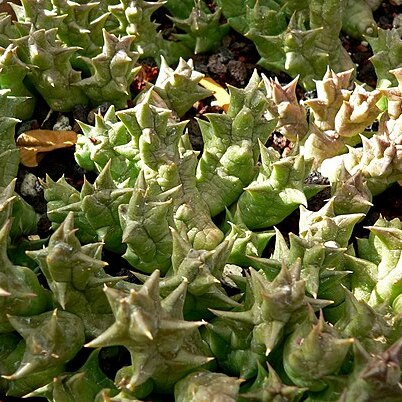Succulent forming clump 50 mm-1 m diam., not rhizomatous. Stems 30-100 mm long, 20-40 mm thick (excluding teeth), stout and often nearly cylindrical, shortly decumbent, green heavily mottled with purple-brown; tubercles 4-10 mm long, arranged loosely into 4 very broadly obtuse rows along stem ± without groove between rows, tapering into spreading conical stoutly acute tooth, sometimes with 1 or 2 denticles near apex. Inflorescence 1 per stem in lower half, of 1-2(-4) flowers developing in gradual succession from short peduncle mostly <10 mm long; pedicel 25-40 mm long, 4-5 mm thick, heavily striped with purple-red, spreading with upturned apex holding flower facing upward on ground; sepals 6-8 mm long, 3-5 mm broad at base, ovate, acuminate. Corolla 70-100 mm diam., rotate; outside smooth, pale green to deeply suffused with purple-brown, with 3-5 longitudinal darker veins running down each lobe and fading towards base of tube; inside rugose with transverse papillate ridges on lobes and around annulus, obscurely rugulose on annulus becoming smooth towards centre, pale greenish yellow to bright yellow variously spotted and lined with purple-brown, bright yellow under annulus and with dark purple-brown ring around base of gynostegium; tube very shallowly bowl-shaped and slightly pentagonal, formed around gynostegium by thick (3-4 mm) annulus 8-10 mm tall and recurved so that rim often touches corolla surface outside tube, with narrow ring of cylindrical-acute black bristles in base around gynostegium; lobes 25-32 mm long, 20-25 mm broad at base, spreading to recurved, broadly ovate, acuminate, often with dense fringe of short (<1 mm) clavate rigidly fixed marginal cilia except towards bases and apices. Corona ±8 mm tall, 16 mm broad, raised above base of tube on stout cylindrical often dark purple stipe 1-2 mm long; outer lobes 6-8 mm long, 1.5-2.0 mm broad, initially horizontal then ascending, linear or linear-lanceolate, acute, yellow dotted with purple-brown with larger purple-brown patches at base; inner lobes 1.2-1.5 mm long, adpressed to backs of anthers then slender ± terete connivent-erect with clavate-tuberculate usually recurved tips, with slight rounded dorsal gibbosity at base, yellow dotted with purple-brown.
More
Like O. ciliata but spreading up to 100 mm x 1 m, stems up to 40 mm diam., pedicels 25-40 mm long, corolla with broad, recurved annulus, inside densely rugulose and glabrous, yellow, spotted and lined with purple-brown, lobes 20-25 mm broad, with short, marginal cilia, corona yellow, spotted with brown, outer lobes linear, 6-8 mm long, inner rising beyond anthers and recurved, with clavate tips.
A succulent plant that forms clumps. These can be 50 cm to 1 m across. The stems are 3-10 cm long and 2-4 cm thick.

